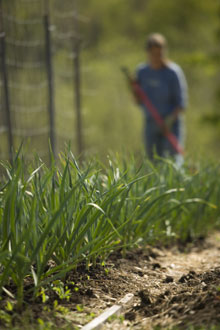





As a founding employee of Gardener's Supply, I wore many different hats over the years. Currently, I have my own company called Johnnie Brook Creative. The gardens around my home in Richmond, VT, include a large vegetable garden, seasonal greenhouse, cutting garden, perennial gardens, rock garden, shade garden, berry plantings, lots of container plants and a meadow garden. There's no place I'd rather be than in the garden.

An organic approach to pest and disease control can be both safe and effective.
Insect pests and plant pathogens are a challenge for every gardener and the temptation to wipe them out is strong. We encourage you to resist the urge to reach for an arsenal of chemical weapons. In the short term they may provide a quick knock-down to the attackers, but they may also kill beneficial organisms. In the long term, you expose yourself and the environment to toxic chemicals, and risk disrupting the natural ecosystem in your garden. All things considered, an organic approach is both safer and more effective.
Your Garden Is an EcosystemOrganic methods of pest and disease control mean a healthier garden for you, your plants and the insects, birds and animals around you. Organic pest controls do not try to eradicate all insects. In fact, the vast majority (95 percent) of insects are benign or beneficial.
Instead, the organic approach requires that you spend a bit more time in your garden, take extra good care of your plants, and keep an eye out for early signs of insect attack or disease symptoms. As gardeners, we can learn to tolerate some damage to our plants, and use this damage as a signal that our plants might need more attention.
Insects play an important role in the garden. Not every insect is an enemy. Some are pollinators, some break down organic matter, and some are beneficial predators that feed on the real enemies. You want to be able to identify your friends and foes, and then encourage the friends and frustrate the foes. Effective and appropriate solutions, such as physical barriers, traps, and specific biological agents, are available to assist in your efforts to protect your garden and at the same time maintain a healthy, natural environment.
Care of Your PlantsInsects and diseases are attracted to stressed, damaged or otherwise unhealthy plants, so the key to preventive control is taking good care of your plants. That means paying close attention to them and providing the conditions they need for healthy, vigorous growth.
Grow your plants in healthy soil. Add organic matter to your garden every year to improve nutrient levels, soil structure, and water-holding capacity. Make sure your plants are getting water and nutrients they need, supplemented with organic fertilizers if necessary. Don't force plants to compete for water and nutrients. Control weeds with mulches, such as landscape fabric or plastic, and make a habit of pulling a few weeds every time you visit the garden. Thin your seedlings so they are not overcrowded and there is good air circulation between them; check seed packets for thinning instructions.
Make annual garden cleanup part of your routine. Leaving old squash vines, tomato plants, and similar debris in your garden after the harvest ends is like putting out a welcome mat for pests and pathogens. Many insects overwinter in such debris, and they will get an early start nibbling on your plants the following spring. Many plant pathogens also live in the soil year-round.
Remove and dispose of any diseased or infested plants. Turn other debris into the soil or put it in your compost pile. Loosen the soil with a fork or spade so that any remaining eggs, larvae, or pupae will be exposed to birds and cold temperatures. Mow or remove the weeds around your garden, since they can also harbor insect pests.
Rotate your crops. Many insects and disease-causing organisms overwinter in the soil near their host plants. If you grow the same plant (or a related one) in the same place the next year, you give those pests a big head start. Crop rotation can reduce insect damage and minimize exposure to soilborne disease organisms. Wait at least two years before planting the same or related crops, such as broccoli and cauliflower, in the same spot. Brassicas, potatoes, tomatoes, and onions are particularly vulnerable to disease problems when planted in the same place year after year.
Crop rotation also helps keep soil nutrients in balance. A first-year planting of heavy feeders, such as tomatoes and lettuce, can be followed by legumes, such as peas and beans, which actually return some nitrogen to the soil. The third year, you could let the soil "rest" by planting light feeders, such as carrots or beets.
Encourage diversity: If you place smaller groups of plants throughout the garden, rather than planting all of your potatoes, say, in one place, it will be more difficult for pests to converge on the whole lot.Interplanting herbs and flowers is another effective way to protect your garden. Some plants, such as marigolds and nasturtiums, seem to repel insect pests. Others, such as dill, mint and fennel, attract beneficial insects that prey on garden pests. Mixing some of these plants into your vegetable garden will foster a more diverse and naturally healthy ecosystem.
More information: Companion Planting in the Kitchen Garden Planner
Timed planting: Insects usually appear at about the same time every year, so you can try to schedule your plantings to avoid the heaviest feeding stages.Keep records to gain familiarity with these patterns in your own region and microclimate.
Resistant varieties: Certain varieties or cultivars show a strong natural resistance to pests and/or disease.Plant breeders also select for disease and pest-resistant characteristics. Seed packets and plant labels usually indicate these desirable qualities.
Copyright © www.100flowers.win Botanic Garden All Rights Reserved